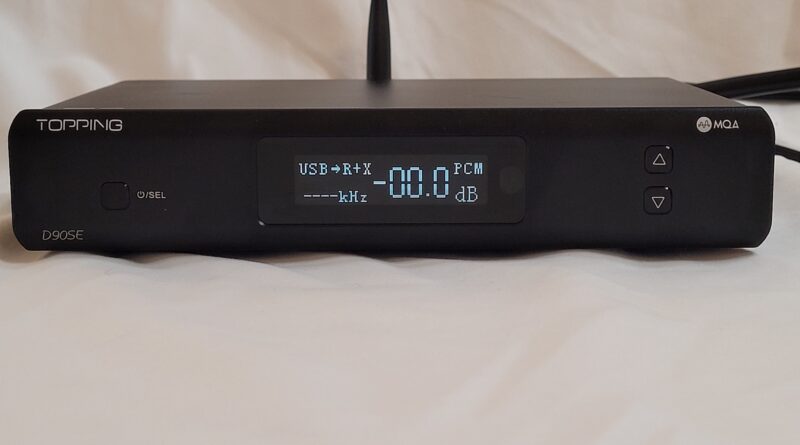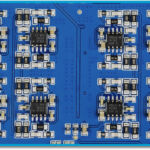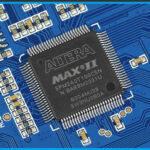
Disclaimer: Apos Audio sent the D90SE for review as a loaner. I have no financial interest in Apos Audio, or Topping, and received no compensation for this review. I am using an affiliate link here at the request of Apos Audio for tracking purposes, but do not claim proceeds from the use of this link. Increasingly vendors are requesting use of affiliate links so you may see more of them added to my reviews for tracking purposes, rest assured I have no intention of monetizing this site. For more information about the D90SE, see Apos Audio, or Topping’s website.
Unbox/Packaging:
Those familiar with topping products will recognize the packaging of the D90SE as it follows the trend with a matte black box with the Topping name on top. Details of what is in the box are provided by a label on the side. Lifting the top reveals the DAC tucked into a foam surround protected by a plastic bag with compartments cut in the foam for the accessories A little more unpacking and you have the USB cable, power cable, Bluetooth antenna, and remote unpacked. The addition of a set of RCA cables or XLR cables so you don’t have to go dig for them would be appreciated but otherwise it is a fairly complete kit.
Build:
The chassis anodized aluminum and is available in either matte black or brushed metal finishes. The only visual differences between the D90 versions are the inclusion of the MQA logo on the 2nd gen model at upper right and the D90SE logo at lower left on the newest version. The face of the unit from left to right has the power button, display screen, and a pair of up/down buttons at far right that control selector functions and volume when used in pre-amp mode. The rear face from left to Right, the rear of the unit has a pair of XLR outputs followed by the RCA outs. The next block is the inputs starting with an HDMI style IIS input, then an optical (Toslink) and the blutooth antenna port stacked one on top of the other, coax and USB are similarly stacked next in line followed by single XLR for AES input. The last block is the power input which has a standard C13 female port with fusing built in and the power switch. Here again, you’d be excused for not seeing any difference in previous versions as the D90 MQA sported exactly the same layout externally. Overall heft of the unit is gratifying as well as it feels very solid in hand with no rattle, lose ports, or wobble to any of the sockets. It looks equally at home in my headphone setup or replacing my Bel Canto in my home setup. Props to Topping for looking the part of a high end unit, now about that remote…. (Unfortunately, the same universal remote used with all topping DAC/amps has shipped with all versions of the D90 and is not the quality of the rest of the unit. Its time for an app to replace remotes anyway so how about it topping?)
Internals:
If one could be forgiven for not noticing the external differences in D90 versions, the same cannot be said for internals. Previous generations of the D90 relied on AKM 4499 DACs while this newest iteration uses the ESS9038 Pro 8 channel DAC chip with 4 channels summed into each output for reduced noise and improved performance. The D90MQA brought the Xmos216 USB processor that allowed for full MQA decode via USB but other inputs were still limited to PCM only for some and PCM/DSD for others. The D90SE improves on that with full MQA decode, unfolding, and MQA studio are now supported via all the inputs except IIS. USB and IIS input support 32/768k PCM. The USB offers DSD512 native support while the IIS offers all the way up to DSD1024. The Coax/Optical/and AES are still limited to 24/192 PCM and DSD64 (DoP) but now do add MQA support. Even Bluetooth has upgrades with a new bypass of its internal DAC circuits and a direct pipe into the ESS9038Pro for improved sound quality. Bluetooth supports AptX Adaptive, and LDAC as well as AptX-HD, and AAC so the full gamut of sources should be compatible. Another new trick in the D90Se’s bag is the addition of a new high-power option that increases RCA output to 2.5V and XLR output to a full 5V. This allows the user to set output to 4V for standard consumer gear or 5V for professional gear and gives the D90SE an even broader range of applications.
For all the added power and new features of the D90SE, Topping has not forgotten what got them here. THD+N is insanely low and pushes the boundaries of what my analyzer is capable of measuring. Others have tested the D90Se and found nearly 135 dB of dynamic range using the XLR outputs and a THD+N of <0.00007% for RCA out both of which are certainly class-leading and quite possibly about as good as it gets regardless of price.
Settings:
The D90SE, much like its predecessors requires that the power button on front be held in while powering on the unit to enter setup mode. From there options of switching between DAC and Pre-amp mode are available. This prevents accidentally switching modes and destroying your hearing but does seem a bit antiquated and less than intuitive compared to some other models. Another thing to remember is that just changing the setting doesn’t save it. You have to go through the options to option # 13 to save the settings and restart the unit. A 14th option does exist but is rarely used as it is factory reset.
Topping D90SE Settings
In operational mode, the D90Se is designed to be controlled using the remote as the single button on the front of the unit serves as on off and input select, but all other functions require the use of the remote to access. Down the left side of the remote, you have Power, a headphone button that is not used, the FIR Filter select button, and the Auto button which turns on and off automatic standby. Filters available are Sharp, slow, short-delay sharp, short-delay slow, super slow, and low dispersion short-delay when using PCM input and 37kHz or 65kHz when using DSD input. IIS and DSD phase settings can also be adjusted. The Auto-standby feature allows the device to go to sleep when no signal is detected and power back up on signal introduction. For the most part I found this worked well but did occasionally clip the first note while waking up. Down the right side of the remote we have mute at the top, display brightness at the bottom, and two unused buttons between. On the wheel in the remotes center, up and down are volume control in pre-amp mode, while right and left are input selection and the center of the wheel controls output selection. Pairing bluetooth is enabled by holding down the Brightness button until the display indicates pairing. The unit must be in bluetooth mode before holding down the button as it will not initiate bluetooth mode if the unit is not already in it.
Sound:
While all this is good to know, unless the D90Se sounds at least as good as previous generations it doesn’t matter much. I matched my previous listening tests so I had a solid compare of the earlier model to the current release. I tried the D90 in both my home system as replacement for my Bel Canto 2.7 and in my headphone rigs replacing either my RME ADI-2, the Burson Swing, or a Bifrost MB. As mentioned in the previous review, the Bel Canto and RME units are a good bit more costly and it probably isn’t quite fair to expect the same level of performance out of the D90SE, but it comes closer than it has any right to for half the sticker of the other two.
My home rig hasn’t changed since the last go around except for the Triode TRX-1 that went back after review. My main system is a Bel Canto 2.7 DAC, Bryston Pre-amp, Levinson 23 amp and Magnepan 3.7s. Trading the D90SE into the Bel Canto spot using a fully balanced chain makes a small difference and quite frankly it favors the D90SE. Both are very clean, detailed, and crisp but the D90Se is a bit more authoritative in the lows and has better note weight throughout the range. Previous iterations of the D90 could easily have been mistaken for ESS based DACs with their analytical nature, but the D90SE is unmistakably the mighty 9038Pro as it as clean as anything I’ve heard short of the Chord Dave and might actually be closer to it than I’d like to admit. I had said that I could live happily with the D90 in place of the BelCanto and now I am considering putting the BelCanto 2.7 up for sale and keeping the review sample D90SE in its place.
Likewise, when replacing the ADI-2 in my headphone rig the D90Se showed improvements over the previous generation and was a bit closer to the ADI-2 in clarity and detail. Again the D90Se is a bit fuller compared to the slightly leaner presentation of the ADI-2. Transients are now a draw with both the D90SE and ADI-2 being extremely quick. Honestly if one does not need the recording capability of the big RME, the D90SE is a better spend and leaves you with more to spend on the rest of your system or less to spend overall.
The D90SE likewise replaced the Burson Swing without the noted drop in clarity and transient speed I had noted previously. Again the D90SE has proved to be at least the equal of a modified Swing with SparkOS op-amps throughout. The Bifrost MB presents a thicker, richer tone, but sounds overly smoothed compared to the D90Se with a good bit of attendant detail loss. The Bifrost MB will likely be heard as a touch more musical at the expense of detail but that cost if fairly high as the D90Se delivers a lot better resolution when put side by side with the Bimby. I don’t think the difference in sound here is a knock on either product, just they are designed to satisfy two different consumers with the Bifrost MB being more forgiving of poor source and the D90SE being more technical in its presentation but less forgiving.
Conclusions:
Topping has built an enviable reputation for producing products that measure exceedingly well and sound just as good all at price-points that are forcing other makers to rethink their price structures. The D90Se is just such a product. It improves on the already quite successful D90 line with even better measurements, an arguably even more capable DAC chip, and improved functionality and MQA support. Previous generations of the D90 challenged DACs costing double and triple its asking price and now the D90Se not only challenges those same products, it bests some of them. It is getting increasingly difficult to find reasons to spend more on a DAC than the cost of the D90Se and when paired with an A90 amplifier, it represents a viable end-game combo for many at a mid-fi price. At the risk of being redundant, check out the D90Se and if you are in the market for a new DAC/AMP combo, check out Apos Audio’s D90Se/A90 Ensemble that comes with the needed cables included. At $1410 + plus tax, I’m betting you’ll be hard pressed to do better than the value that combo respresents. Highly recommended.
- Packaging - 7/10
- Accessories - 7.5/10
- Build Quality - 8/10
- Input Flexibilty - 8.5/10
- sound quality - 8.5/10
Summary
Pros: Great build quality, near reference sound, MQA support available on most inputs, 5V output mode
Cons: universal remote not of same quality as main unit, some controls a bit clunky to manipulate.




















Post a Comment